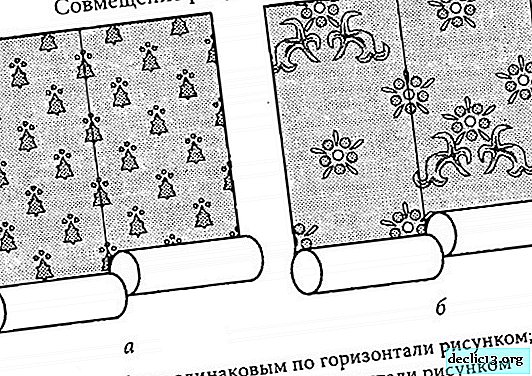Before wallpapering
Wallpaper is glued to a pre-plastered surface or drywall. Never experiment with sticking new wallpapers over old ones. In the case of a painted surface - the walls are quite simple to wash. A porous or unpainted surface must be treated with wallpaper glue, without such a procedure, the wallpaper panel will be difficult to move along the wall, which will affect the combination of the picture. Before directly applying the wallpaper, the glue on the wall must dry.
Before gluing wallpaper, the walls need to be leveled and primed. You can read about how to quickly remove old wallpapers here.
Stripping, primer and putty
Room layout
It is recommended to start gluing from the corner - this helps to hide pattern defects with poor-quality combination of panels that are pasted first and last. If the room has any kind of architecture (arch or fireplace), and the wallpaper has a rather large pattern, then the first panel must be glued with a pattern along the axis of the architectural element. Other panels are glued on both sides of the original. Having decided on the starting point, in the future you can use the roll in the form of a template for marking on the surface the position of the panels. Thus, it is possible to determine the location of joints in inconvenient places and, if necessary, change the starting point.
Preparing for wallpapering
If before you did not encounter a similar procedure and "do not want to break firewood", then it is better to use a wallpaper with an arbitrary pattern. This will help focus on the technique, rather than combining the pattern. By the way, for beginners it is better to use wallpaper with a ready-made adhesive layer.
Work begins with determining the direction of the pattern. It can be seen on the roll in the corresponding arrow, which indicates the flow.
Cutting wallpaper with a pattern
To begin with, we will deal with the nature of the pattern on the wallpaper, because the pattern can be either symmetrical or asymmetrical with respect to the axis of the canvas. When calculating the number of rolls, this also matters. The length between the repeating wallpaper pattern is called a rapport or just a pattern step. The step length can vary from 5 to 30 cm. The longer the step length, the more difficult it is to adjust the pattern and accordingly there will be more waste.
It is necessary to measure the height of the wall and add 10-15 cm from each end to fit, then expand the roll and arrange the panels. If the workplace has the necessary dimensions, then it can be used as a template. First you need to cut off the panel with a small pass of 50 mm. The pattern on the second canvas must be combined with the pattern on the first. At the workplace, one can note the length of the panels and the placement of the pattern for odd and even panels. The horizontally identical wallpaper with a pattern on opposite edges has matching halves of patterns. The horizontally different wallpapers on opposite edges of the matching halves of the patterns are often shifted half a step from the pattern (see figure).

How to choose a glue for wallpapering
Successful sticking depends on the right choice and application of glue. First of all, when buying wallpaper, always pay attention to the manufacturer's instructions for the use of adhesives. If there are none, then you can ask about specials. store or seller. It is imperative to determine whether glue with added fungicide is necessary or not. Such an adhesive mixture prevents mold, therefore it is used when gluing washable or vinyl (waterproof) wallpapers. The packaging indicates the type of glue and the consumption of material for the number of wallpapers.
Organic and synthetic adhesive mixtures are available in both solid and liquid form. The solution is prepared by slowly pouring the contents of the bag and mixing it with the required amount of water. To prevent various lumps, the solution must be continuously mixed, and then let it thicken and settle (the required time is indicated by the manufacturer). The glue is able to store its properties for about one week, but at the same time it must be kept in an airtight container.
Liquid glue is immediately poured into the container and used in the work.
Glue application
First you need to lay the panels on the working surface with the pattern down. Then we apply glue to the middle of the panel and spread it on the sides with a brush. Particular attention must be paid to the edges. If the glue got on the floor, then it is better to immediately wipe it with a damp cloth. Did you spread the canvases? Ok, now we put them inside with glue. This procedure will facilitate the transfer to the wall and prevent drying out. If necessary, you can fold the cloth again.

All wallpapers, except very thin ones, should be left to impregnate: 2-3 minutes for less dense, and up to 15 for more dense. Duration is usually written in the instructions on the package. Wallpaper impregnated with glue will prevent the appearance of bubbles and soften them, which allows you to simplify the direct process of pasting. Therefore, it is better to put aside the cloth smeared with glue to the side and begin processing another. When working, it is necessary to be careful not to get glue on the front part and the workplace, on which the subsequent roll will fall. To do this, you can put several layers of paper on the desktop and remove them as the wallpaper is processed. By the way, we answer your future question: "no, the newspaper cannot be used, otherwise newspaper ink will add its own part of the decor to your wallpaper."

















